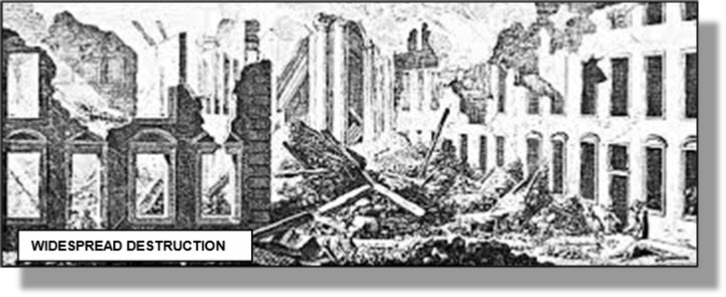


THE LISBON EARTHQUAKE 1755 (G2)
xxxxxA massive earthquake off the coast of Portugal -
 xxxxxThe earthquake, one of the most powerful ever recorded, struck Lisbon at 9.40 am on the morning of November 1st 1755. It was All Saints' Day -
xxxxxThe earthquake, one of the most powerful ever recorded, struck Lisbon at 9.40 am on the morning of November 1st 1755. It was All Saints' Day -
xxxxxWith the help of much foreign aid, the city was rebuilt with astonishing speed. The country's crown minister (and virtual dictator), Sebastiao de Carvalho, appointed five architects, led by his chief engineer Manuel de Maia, and these were given the task of redesigning much of the capital. Plans were quickly put forward for redeveloping the Baixa, the city centre on the north bank of the river Tagus, an area that had been virtually destroyed. Most of the churches and civic buildings were repaired or rebuilt in a simplified Baroque style, but the 14th century Carmel Church was left as a ruin, looming over the city as a sad reminder of the horrific tragedy. Today its Gothic shell serves as an archaeological museum. The Palace of the Inquisition, completely destroyed, was not rebuilt, but the site was later used for the building of the National Theatre in 1845, during the reign of Dona Maria II. Nor were the offices of the Jesuits restored. The Order was banished and the site used for the building of St. Joseph's Hospital.
Acknowledgements
Lisbon: contemporary woodcut by the English printer and publisher Robert Sayer (1725-
G2-

xxxxxThe epicentre was situated some distance from the Portuguese coast. It caused damage as far away as Algiers, over 600 miles to the east, and it is said that waves at the port of Cadiz reached a height of 60 feet. According to one account the waves were still 12 feet high when they reached the island of Martinique in the eastern Caribbean Sea -

xxxxxInx1760, the English geologist John Michell (1724-
xxxxxIncidentally, a year later the French writer Voltaire wrote a poem about the earthquake entitled Le Désastre de Lisbonne.


